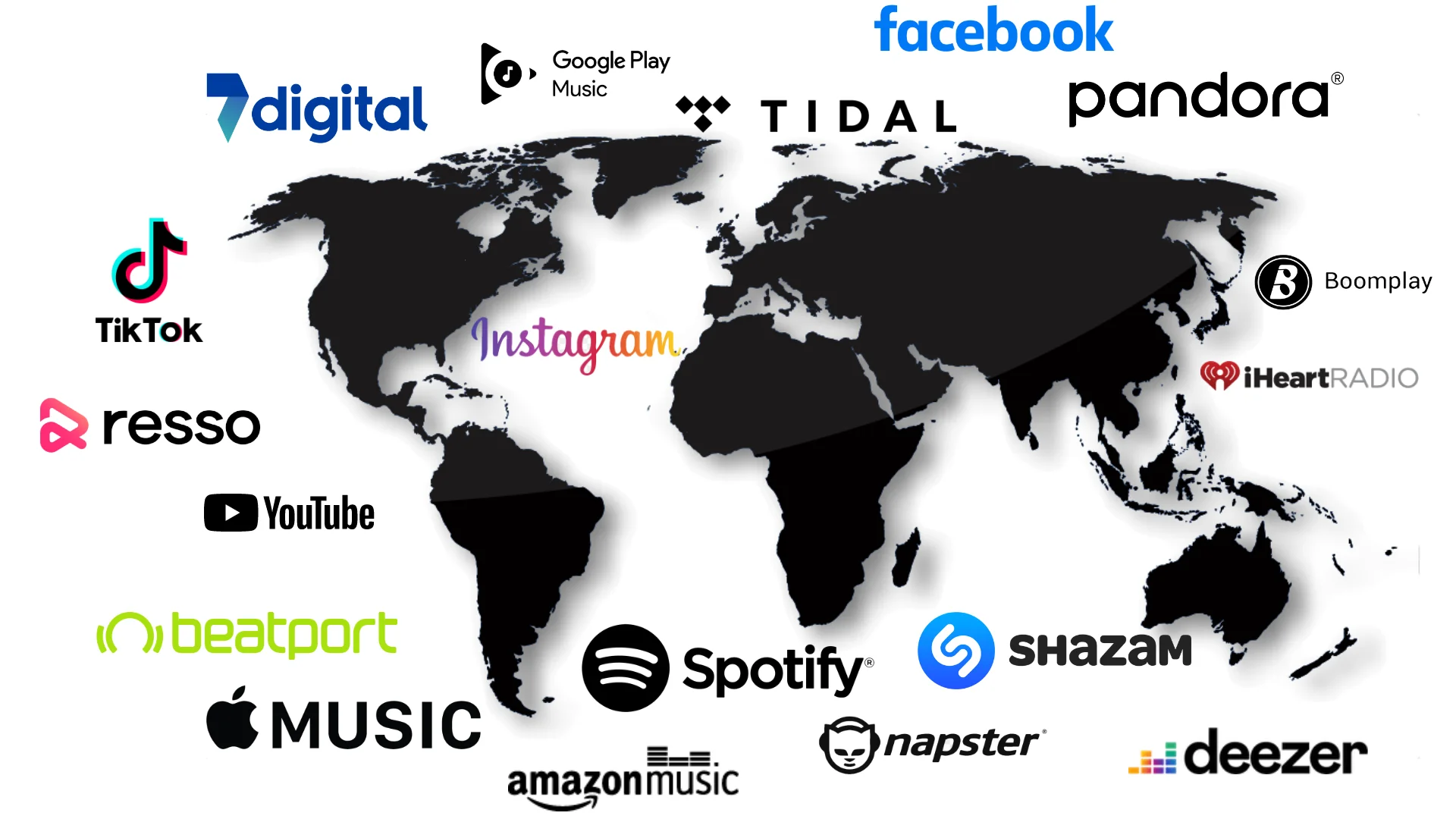By Johnny Punish
The music world is spinning faster than ever. Every month, something new drops — AI, new streaming rules, new ways fans find songs. For indie musicians, it’s a full-time job just figuring out where to put our music so it actually gets heard.
As we roll into 2026, more than 120,000 songs hit Spotify and other distributors every single day. It’s chaos. But it’s also opportunity — if you know where listeners really are. So I’ve done the research and put together a list of the Top 10 Music Platforms for 2026 — plus a new bonus section on how to break into the huge China music market.
#1 Spotify
Spotify still rules the world of digital music. With over 600 million monthly listeners, this is where discovery happens. Playlist placements can launch a career. The downside? Streams pay in pennies — so think exposure first, income second. Use Spotify for reach and fan analytics, but keep your business elsewhere.
#2 YouTube & YouTube Music
YouTube is the planet’s biggest music search engine. If you make videos — lyric, live, or storytelling — this is your kingdom. YouTube Music keeps growing fast, giving you a second channel to monetize the same song. For artists who think visually, this platform is essential.
#3 Apple Music
Apple Music keeps things premium. Fewer casual listeners, more real fans. Payouts per stream are higher than Spotify, and the audience skews toward people who still value the craft of music. Great for polished artists and album-driven releases.
#4 TikTok Music
TikTok continues to dominate short-form virality — and now with TikTok Music, users can jump from clips to full streams instantly. If your track catches a 15-second wave, millions can find it overnight. Collaborate with content creators and let the algorithm do the heavy lifting.
#5 Amazon Music
With its Prime integration, Amazon Music quietly built one of the largest user bases in the world. It’s especially strong with older demographics and everyday listeners who aren’t deep into the music-app ecosystem. If you want mainstream ears, you can’t skip this one.

#6 SoundCloud
SoundCloud remains the underground hangout — perfect for indie, experimental, and DIY artists. But their new anti-AI policies are shaking up how creators distribute. For those using modern AI tools like Suno or Udio to produce or mix, SoundCloud’s stance may block monetization. Still, for community, networking, and early discovery, it’s unmatched.
#7 Audiomack
Audiomack keeps thriving in the hip-hop, Afrobeats, and world-music scenes. Their “creator-first” monetization model is refreshing, and they’ve grown fast in Africa and Latin America. If your sound leans global or urban, this is your tribe.
#8 Deezer
Deezer is still strong in Europe and Latin America, and they’re leading the way with their artist-centric payout model — meaning your fans’ money actually goes to you, not to whoever has the most streams. Fairer and more transparent than most of the big players.
#9 Bandcamp
Bandcamp continues to be the home of authentic indie culture. Fans buy your songs and merch directly from you — no middlemen, no algorithms. With more artists leaving streaming for fan-funded ecosystems, Bandcamp remains the soul of the indie world.
#10 Tidal
Tidal is all about sound quality and artist respect. Their HiFi streaming and fairer royalties make it a great fit for musicians who care about audio detail and ownership. It’s not the biggest, but it’s one of the most artist-friendly platforms out there.
Bonus: How to Reach the Massive China Music Market
Here’s the truth — China’s music market is gigantic, but most Western artists aren’t even on the radar there. We’re talking about hundreds of millions of active music listeners who use Chinese-only platforms that Spotify, Apple Music, and YouTube can’t reach. The good news? You can get in — you just need the right tools and partners.
The Big Players in China
1. Tencent Music Entertainment (TME): QQ Music, KuGou, KuWo
TME runs three of China’s biggest platforms — QQ Music, KuGou, and KuWo. Combined, they reach hundreds of millions of monthly users. Their Tencent Musician Platform lets indie artists upload directly, though you’ll want a distributor familiar with local rules, metadata standards, and licensing.
2. NetEase Cloud Music
NetEase Cloud Music is huge with younger listeners and has a passionate social element — comments, shares, playlists, fan discussions. It’s a goldmine for cross-cultural connection and global indie discovery. As of 2025, they host over 600,000 registered independent artists and 200+ million monthly users.
3. Kanjian Music (via RouteNote)
Kanjian specializes in helping indie artists reach the Chinese market. Distributors like RouteNote partner with them to place music on China’s top DSPs. This route simplifies compliance, metadata translation, and royalty collection.
China Music Trends
- TME surpassed 100 million paying users in 2025, showing that fans in China are now paying for streaming.
- NetEase continues to attract international artists looking for younger, more social audiences.
- Local AI-music tools are emerging fast — meaning China’s scene is evolving at lightning speed.
How to Distribute Your Music in China
- Pick a Distributor That Covers China: Choose partners like RouteNote, LabelGrid, or others that deliver to Tencent and NetEase.
- Localize Metadata: Translate your song and album titles, use simple keywords, and make sure cover art appeals to the Chinese market.
- Understand Royalties: Payment cycles can take longer. Confirm how your distributor handles Chinese DSP payouts.
- Respect Regulations: Avoid politically sensitive or banned content — China monitors lyrics and visuals closely.
- Engage Fans: Collaborate with local influencers or cross-promote with Chinese indie artists to grow authentic fans.
Bottom line? The Chinese music scene is massive, loyal, and growing fast. Get your songs there early, and you might find a whole new audience hungry for your sound.
SPECIAL REPORT
TOP 5 GENRES OF MUSIC IN CHINA
As of 2025, China’s music landscape is vibrant and diverse, reflecting a blend of traditional influences and contemporary global trends. Here are the top 5 music genres currently popular in China:
1. Mandopop (Mandarin Pop)
Mandopop continues to dominate China’s music scene. Artists like Jay Chou and Jolin Tsai remain household names, and the genre’s influence extends beyond mainland China, impacting Taiwan and Southeast Asia. The genre’s appeal lies in its catchy melodies and relatable lyrics, resonating with a broad audience.
2. Hip-Hop
Hip-hop has seen a significant rise in popularity, especially among younger audiences. Chinese hip-hop artists are gaining recognition both domestically and internationally, with platforms like “Rap of China” showcasing local talent. The genre’s growth is fueled by its authentic expression and cultural relevance.
3. C-pop (Chinese Pop)
C-pop encompasses a range of styles, including Mandopop and Cantopop, and has gained international attention. The genre’s fusion of Western pop elements with Chinese cultural themes appeals to a global audience, contributing to its expanding influence.
4. Electronic Dance Music (EDM)
EDM has become a staple in China’s nightlife and festival culture. International DJs frequently tour major cities, and local producers are making waves in the electronic music scene. The genre’s high energy and immersive experiences attract a diverse crowd.
5. Indie and Alternative Rock
The indie and alternative rock scene is thriving, particularly in urban centers like Beijing and Shanghai. Bands and solo artists are experimenting with various sounds, gaining a dedicated following through live performances and online platforms.
Understanding these trends is crucial for artists and industry professionals looking to engage with the Chinese market. Tailoring music and marketing strategies to align with these popular genres can enhance visibility and success in this dynamic landscape.
Johnny’s Tips for Musicians in 2026
- Be Everywhere: Don’t rely on one platform. Spread your presence across multiple streaming sites and regions.
- Think Global: The next fan could be in Beijing, Berlin, or Buenos Aires — so distribute smart.
- Stay Transparent: If you’re using AI tools like Suno or Udio, be upfront. Authenticity wins every time.
- Go Visual: In 2026, music is visual. Lyric videos, reels, live clips — they’re all part of your story.
- Own Your Domain: Always control your digital home base — like JohnnyPunish.com — so fans can find you, not just your streams.
About the Author: Johnny Punish is an independent songwriter, producer, and creative rebel making noise from the edges of the music industry. More at JohnnyPunish.com.
Keywords: music distribution platforms 2026, best music streaming sites, independent musicians, Spotify, SoundCloud, Apple Music, TikTok Music, AI in music, how to distribute music in China, QQ Music, NetEase Cloud Music, Tencent Music, RouteNote, Kanjian Music, indie artist marketing














